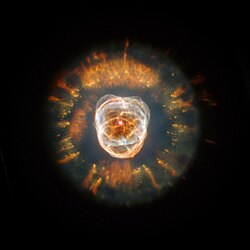Top Qs
Timeline
Chat
Perspective
Eskimo Nebula
Planetary nebula in the constellation Gemini From Wikipedia, the free encyclopedia
Remove ads
The Eskimo Nebula (NGC 2392), also known as the Clown Face Nebula, Lion Nebula,[4] or Caldwell 39, is a bipolar[5] double-shell[6] planetary nebula (PN). It was discovered by astronomer William Herschel in 1787. The formation resembles a person's head surrounded by a parka hood. It is surrounded by gas that composed the outer layers of a Sun-like star. The visible inner filaments are ejected by a strong wind of particles from the central star. The outer disk contains unusual, light-year-long filaments.
NGC 2392 lies about 6500 light-years away, and is visible with a small telescope in the constellation of Gemini.
At the center of NGC 2392, there is an O-type star (designated HD 59088[7]) with a spectral type of O(H)6f.[8]
Remove ads
Historic data
The nebula was discovered by William Herschel on January 17, 1787, in Slough, England. He described it as "A star 9th magnitude with a pretty bright middle, nebulosity equally dispersed all around. A very remarkable phenomenon."[9] NGC 2392 WH IV-45 is included in the Astronomical League's Herschel 400 observing program.
On 9 January 1982 it was occulted by the Moon during a Total Lunar Eclipse (the January 1982 lunar eclipse) over Greenland, the Arctic, the extreme northeast of North America, the northern half of Europe, North and Northeast Asia. This event was seen by several observers in England. The occultation during total eclipse will happen again during the January 2066 lunar eclipse over the northern half of Asia and the Northwest Pacific.[10]: 158
Remove ads
Naming controversy

On 11 August 2020, the IAU Working Group on Star Names (WGSN),[citation needed] NASA/IPAC Extragalactic Database (NED),[citation needed] and SIMBAD Astronomical Database (CDS) discontinued use of three nicknames that were perceived as offensive – "Eskimo Nebula", "Clown Face Nebula", and "Clownface Nebula" – and strongly recommended the nebula be referred to by its NGC designation in further publications.[11][1]
Remove ads
See also
Notes
References
External links
Wikiwand - on
Seamless Wikipedia browsing. On steroids.
Remove ads

